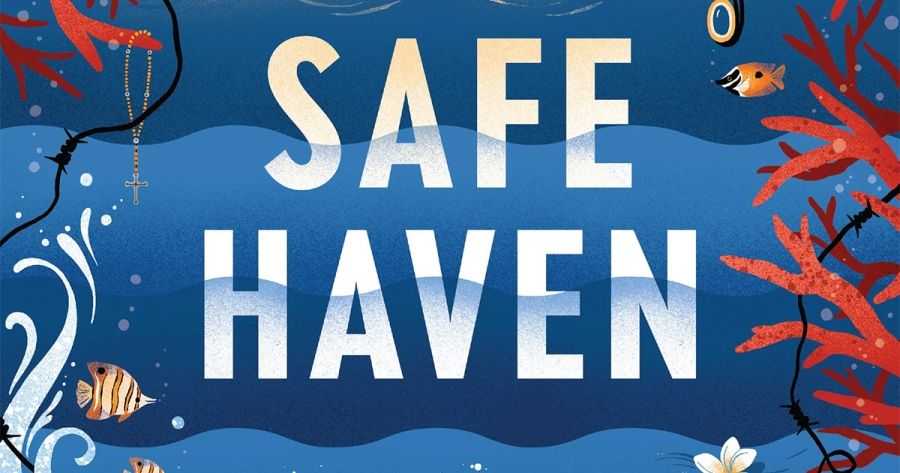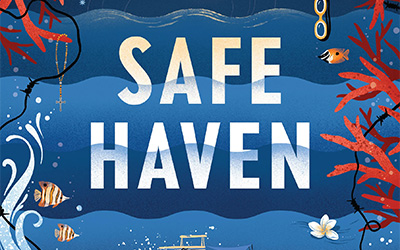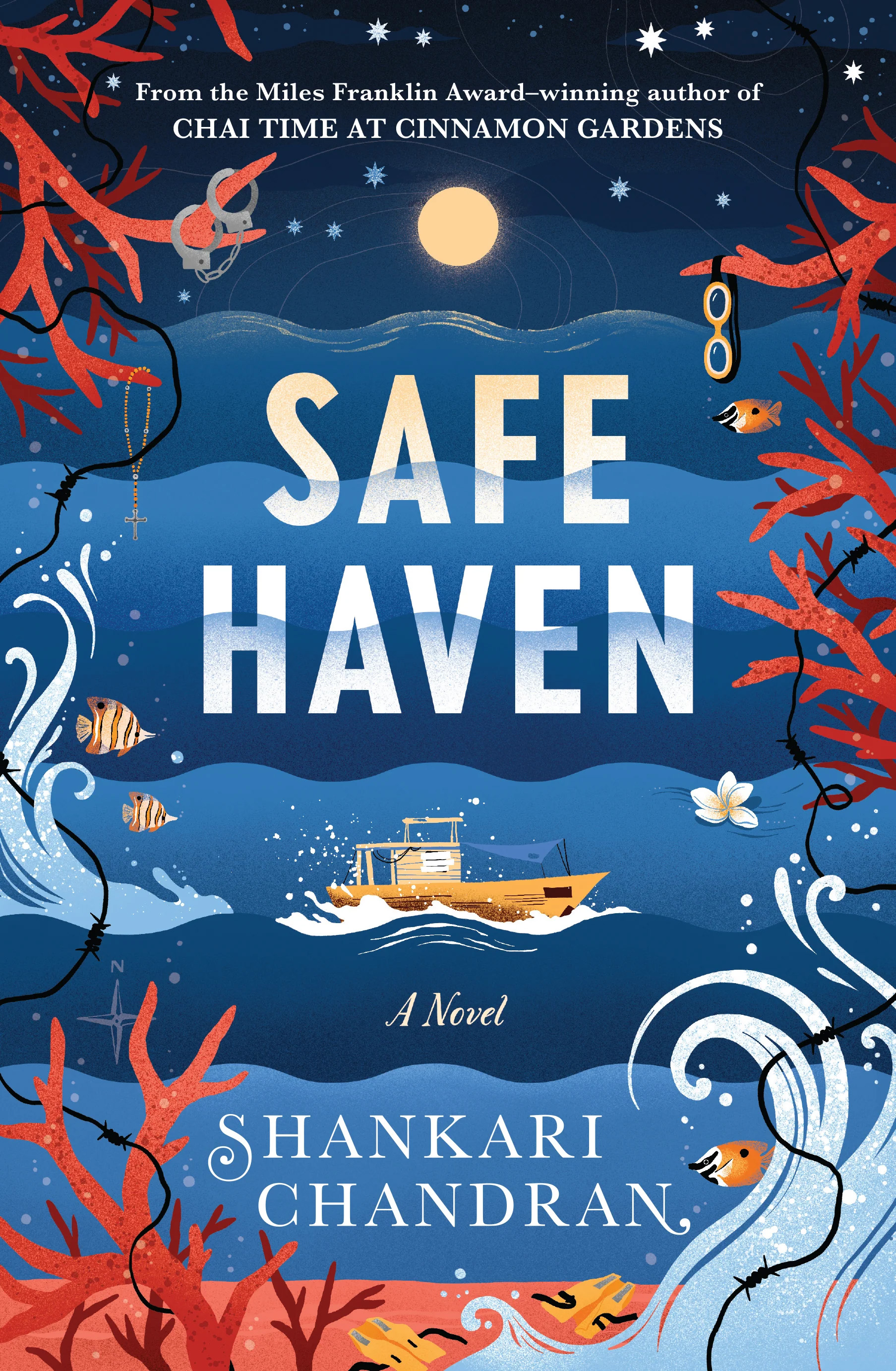
- Free Article: No
- Contents Category: Fiction
- Review Article: Yes
- Article Title: The Not Knowing
- Article Subtitle: A novel oceanic in subject and scope
- Online Only: No
- Custom Highlight Text:
You need to look closely at the cover of Shankari Chandran’s novel Safe Haven to notice the sharp edges of the deceptively inviting image it depicts: the handcuffs, the barbed wire, the boat that seems to sit on top of the waves and yet be at the bottom of the sea, and the rebuke contained in the book’s title.
- Featured Image (400px * 250px):

- Alt Tag (Featured Image): Patrick Allington reviews ‘Safe Haven’ by Shankari Chandran
- Book 1 Title: Safe Haven
- Book 1 Biblio: Ultimo Press, $34.99 pb, 310 pp
- Book 1 Cover Small (400 x 600):

- Book 1 Cover (800 x 1200):

At the story’s centre is Sister Serafina Daniels (Fina), a Tamil Carmelite nun who is one of twenty-five survivors of a boat that sank on its way to Australia, resulting in eighteen deaths by drowning. Fina’s short-term Safe Haven Enterprise Visa allows her to live in the New South Wales town of Hastings with a mother and son – Louisa and Cash – who are dealing with their own trauma. Fina also conducts frequent pastoral visits to the remote Port Camden Detention Centre, where fellow Tamil survivors of her sea journey sit in political purgatory.
After two deaths at Port Camden, one of which affects her deeply, Fina embarks on a course of action that she knows will jeopardise her future. From this foundation, Chandran unfurls a plot involving an inquiry into the two deaths by a young high-flyer investigator from the Office of Special Investigations. Lakshmi – known as Lucky – is a Tamil-Australian woman with a commitment to finding the truth, regardless of her personal safety, a refusal to submit to intimidation, and the ability to break and enter.
Although Lucky’s investigation shapes the novel, Fina stays at the heart of the story, partly because Lucky sees through her façade, and partly because Fina’s commitment to the dislocated and traumatised people she helps is unrelenting. Chandran’s prose is at its most affecting and potent in a scene where Fina and Lucky talk with the Tamil women living in the detention centre, including Selvi, a deeply distressed mother mourning the death of her son. Then and at other moments, Chandran captures detention centre life with a mix of compassion and fury: ‘Days of not knowing their fate quickly became months and slowly became years. The not knowing became known as The Not Knowing.’
In Hastings, Fina makes Louisa’s dysfunctional home functional. She cleans up. She replaces backpacker lodgers with refugee families. She also cares for eleven-year-old Cash in ways Louisa cannot, tending to his practical and emotional needs. The boy relies on Fina, sometimes needing to sleep in her room. His compassion for her is profound: he comforts her when she wakes, ‘sometimes screaming’, from dreams about her past. Chandran does a fine job of depicting an unusual adult-child relationship without resorting to neat comparisons about their respective trauma and without ever forcing Cash to appear prematurely or conveniently adult-like in his wisdom or capabilities.
Fina’s relationship with Louisa is more complex: although they have come to love each other, each of them can be fiercely critical of the other: ‘Are all nuns this bossy?’ Louisa is one of several significant characters whose portrait is sketchy within the crowded story. A mix of people and their backstories compete for attention, including Professor Jafari, a pure mathematician from the University of Tehran who now works at DeLuca’s Hardware; a military doctor called Henry, who schemes and mourns his son; a Norwegian sea captain called Magnus, who came to the rescue of Fina’s sinking boat and now sends her tender emails; the rigid Commanding Officer of Port Camden; several malicious, damaged detention centre staff, ‘contractors or sole traders in matching uniforms’; and a group of Hastings locals with the smarts to support Fina, including Jill, a school counsellor with a high-powered legal background.
All these elements – the politics, the busy plot, the many characters who are pieces in the story’s intricate puzzle – stitch together unevenly. I am not suggesting that Chandran should simplify her vision or constrain herself to the rules of a single genre. But on its own terms, it is hard to settle into the world this novel offers.
Chandran also has much background context she wants to share, including in the novel’s awkward opening pages and in the use of dialogue to feed information to readers. Still, her prose persistently draws startlingly simple and powerful observations from the story’s multiple layers: ‘Hastings’ small primary school had sunshades like sails stretching over the playground that reminded her of UN tents, though these were of much better quality.’
In a later part in the novel, as veneers of truth unravel, Lucky says to Henry: ‘I think we both know that nothing is as it seems here.’ She is voicing her suspicions; she is asking Henry to answer her questions honestly. She might also be summarising Safe Haven, a novel about lies, hidden truths, contested histories, and the callous expediency of institutions and governments.


Comments powered by CComment